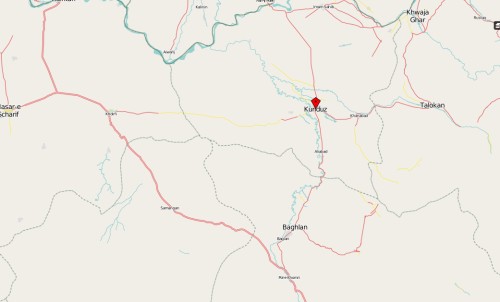Im Norden Afghanistans: Bedrohung durch Taliban weitet sich aus
Dass die Karte vom Norden Afghanistans, von den Provinzen Kundus und Baghlan (Klick macht groß), hier noch mal gebraucht würde, hätte ich nicht gedacht. Aber fast vier Tage nach dem Beginn des Angriffs der Taliban auf die nordafghanische Stadt Kundus zeichnet sich ab, dass nicht nur die Vorstellungen von einer schnellen Rückeroberung durch die afghanischen Sicherheitskräfte gescheitert scheinen. Im Gegenteil: Inzwischen deuten die Informationen darauf hin, dass die Aufständischen auch in den Nachbarprovinzen vorrücken und die Hauptstadt der Provinz Baghlan, Pul-e Khumri, unter ihre Kontrolle bringen könnten.
Die jüngste Zusammenfassung der New York Times am Mittwoch:
The test facing the Afghan government now is not just whether it can quickly mount a counterattack and retake Kunduz, the northern city that fell to the Taliban on Monday, but whether it can prevent a nearby provincial capital from falling as well.
Accounts from the neighboring province of Baghlan on Wednesday showed that the collapse of government forces in Kunduz against less numerous Taliban forces was prompting a crisis of confidence in the neighboring province of Baghlan, where wealthier citizens and those with government connections have begun to leave for the relative safety of their hometowns.In the midst of one of the gravest moments for the American-backed government in Kabul, military leaders spoke for a third day about launching a decisive counterattack against the Taliban in Kunduz. But it was becoming clear that most of the reinforcements for such an attack had been waylaid in Baghlan.
Westliche Militärs hatten zwar eingestanden, dass der koordinierte Angriff der Taliban auf Kundus am vergangenen Montag professionell durchgeführt wurde – die afghanische Armee, die Polizei und möglicherweise auch die Afghan Local Police und Stammesmilizen würden aber in der Lage sein, innerhalb von 48 Stunden die Lage zu bereinigen, zumal die Aufständischen zwar Schlüsselpositionen in Kundus kontrollierten, nicht aber die ganze Stadt. Diese Einschätzung scheint überholt. Offensichtlich sind die afghanischen Sicherheitskräfte demotiviert, bekommen nur langsam Verstärkung, wenn überhaupt, und haben den Aufständischen wenig entgegenzusetzen. Selbst mit Unterstützung von Spezialkräften der NATO-geführten Mission Resolute Support und US-Luftangriffen ist offensichtlich die angekündigte Gegenoffensive bislang nicht gelungen.
Aus einem Bericht der Associated Press:
The swift re-taking of the city promised by President Ashraf Ghani has failed to materialize, as Taliban fighters dig into positions around the city and mine roads to prevent reinforcements from reaching weary Afghan forces.
They have also placed large containers across streets to further limit people’s movement in and out of Kunduz, said Ahmad Sahil, a local television producer who was inside the city.
In another setback for the government, nearly 200 Afghan security personnel abandoned Bala Hissar hill, a key outpost in Kunduz that overlooks the city’s main roads, after running out of ammunition and food, said an Afghan security official. (…)
To the south, in neighboring Baghlan province, a group of 800 Afghan troops on its way to reinforce Kunduz repelled a Taliban ambush and was waiting for bomb squads to clear the road into the city, said Afghan army officer Sayed Ahmad Mujahid.
Allein aus Kundus flohen nach Angaben der Vereinten Nationen rund 6.000 Einwohner – und es dürften mehr werden. Die Berufung eines neuen amtierenden Gouverneurs für die Provinz wird daran kaum etwas ändern.
Dazu passt auch die (in den Kommentaren schon erwähnte) lesenswerte Analyse des Afghanistan Analysts Network: The Fall of Kunduz: What does it tell us about the strength of the post-Omar Taleban?
Weiter nach Entwicklung am Donnerstag – und vermutlich wird diese Entwicklung nicht schön sein.
Nachtrag: Am späten Abend scheint Bewegung in die Sache gekommen zu sein, wenn man die Tweets des TOLO News-Kollegen Muslim Shirzad verfolgt. Inwieweit die Bilder aktuell und aus Kundus sind, kann ich allerdings nicht beurteilen.
More special force deployed. #Kunduz pic.twitter.com/G7Xe9buorO
— Muslim Shirzad (@MuslimShirzad) 30. September 2015
Nachtrag 2: Ein Bericht des sehr kenntnisreichen afghanischen Kollegen Bilal Sarwary: Taliban in Kunduz: What life is like for residents in the Afghan city as extremist’s return to power
“Kunduz fell not because the Taliban have grown excessively strong, but because the Afghan National Security Force [ANSF] is ineffectively led – and capable commanders are undermined by new parallel structures or excessive centralisation. This negatively impacts morale as well as command effectiveness.“
(Karte: OpenStreetMap)




Noch ein Überblick zur allgemeinen Lage:
http://understandingwar.org/sites/default/files/Militant%20Sanctuary%20in%20Afghanistan%20Map_090915%20%283%29_0.pdf
Die ANSF laufen Gefahr relativ schnell viel Raum zu verlieren. Wenn sich nicht schnell etwas ändert, wird es ganz schwer, überhaupt auch nur in die Nähe von Kunduz zu gelangen. Der mehr oder weniger einzige leistungsfähige Weg Richtung Norden, Highway 3 (?), scheint ja bereits jetzt zumindest teilweise gesperrt. Die Straße bzw deren Verlauf bietet für Störungen welcher Art auch immer, mehr als genug Möglichkeiten.
Wenn die Hysterie nun auch in Pul E Khumri um sich greift und die Taliban dies ausnutzen können, dürfte die Aufgabe nicht leichter werden.
Ich hoffe das Beste für die Afghanischen Sicherheitskräfte und natürlich auch für die Bevölkerung, bin aber doch skeptisch für die nächsten Tage.
Vielleicht sollten sie dann doch auf Dostum zurückgreifen. In Faryab war er erfolgreich.
http://www.theguardian.com/world/2015/aug/04/afghan-vice-president-militia-taliban-general-dostum
http://www.dw.com/en/mounting-concerns-as-afghans-form-militias-to-fight-taliban/a-18677580
Von heute 05:42 Uhr: Armee erobert angeblich Kundus zurück
(http://www.tagesschau.de/ausland/afghanistan-kundus-103.html)
und das Interview mit „Militärisch sind die Taliban nicht besiegbar“ mit der Afghanistan-Expertin Adrienne Woltersdorf
(http://www.tagesschau.de/ausland/aghanistan-interview-101~_origin-c99c9c8e-1a64-43ff-bf26-a71419c21696.html
Ach ich sehe gerade, dass die im Artikel erwähnte Einheit den Namen der Balchpprovinz trägt.
Die U.S.- Truppnenpräsenz in AFG steht erneut zur Disposition.
John McCain fordert ein Bodentruppe, die tatsächlicher Lage am Boden gerecht wird. Der White House Pressesprecher hingegen sieht keine Anzeichen, die geeignet ist, die langfristig angelegte Strategie ( des Abzugs) zu ändern.
Gegenwärtig sind noch 9.800 stationiert, die nach Obamas Absicht auf wenige 100 in 2016 reduziert werden sollen, in Obamas letztem Jahr als Commander in Chief!
Der gegenwärtige U.S. – Kdr, General John Campbell, wird dazu am 6. Oktober vor dem Kongress aussagen.
http://thehill.com/policy/defense/255463-coalition-us-conducts-more-airstrikes-in-afghanistan?utm_source=dlvr.it&utm_medium=twitter
Vorl Fazit, es tut sich was hinsichtlich der Präsenz am Boden. Sollten die USA ihre Abzugspläne schieben, oder gar umkehren, haben Kanzlerin und IBuK eine weitere Baustelle.